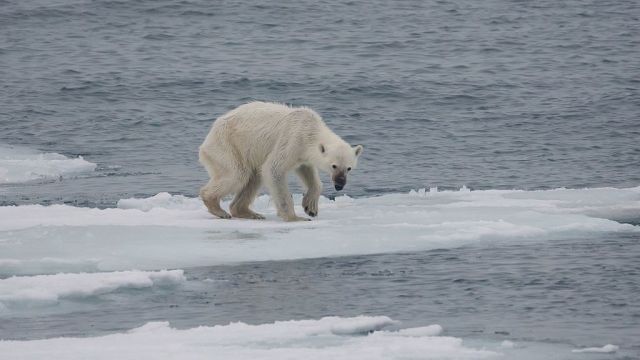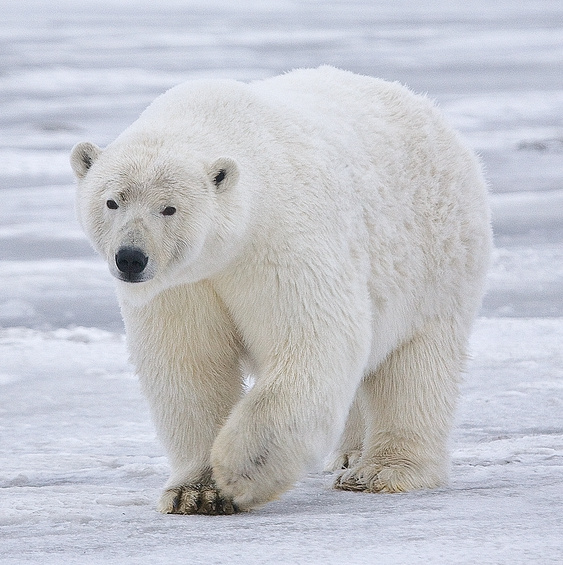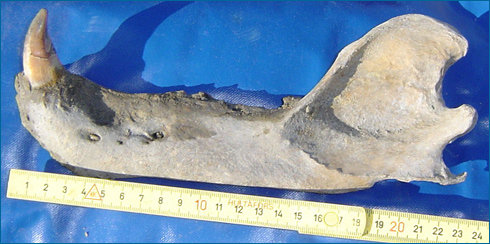No other animal symbolises climate change like the polar bear does. Just like the dodo has become the standard animal representing extinction, the polar bear has become recognised as the animal signifying our impact on the planet’s rapidly warming climate.
TV programmes, newspapers and magazines all use an image of a polar bear when talking about climate change. There is the classic image of a lone polar bear standing on all fours on a small piece of ice, in the vastness of empty water. The fur is wet, and clearly this large creature is being portrayed as being very cold. Its thick padded, webbed feet, grip onto the freezing ice. The great white bear is looking out longingly to sea, searching for that next piece of ice it can swim to, hoping that there is a tasty seal just lying there waiting.
It is an extremely powerful image. A great creature, losing its home because of our selfishness. It is a stark reminder of the enormous effect we can have on our home; the home of millions of different species, each unique, and each just as beautiful as the next.

A starving polar bear on extremely thin ice, at Svalbard. (Photo by Andreas Weith. Public Domain)
Polar bears belong to a rather remarkable genus in the bear family, Ursus. Species from this group have conquered the northern hemisphere: the brown bear (Ursus arctos) living in North America and Eurasia; the widely distributed American black bear (Ursus americanus); the tree loving Asian black bear (Ursus thibetanus); and the one that made its home with the sea and ice, the polar bear (Ursus maritimus). For just one genus, this is hugely successful: species are found all over North America, and Asia, and even the northern cold ice sheets. In the past there have been over a dozen different types of bear placed in this genus, including the giant Cave Bear.
Out of the four living species, the polar bear is the largest. And perhaps the most bizarre.

The beautiful polar bear (Ursus maritimus) in Alaska. (Photo by Alan Wilson. Public Domain)
Polar bears are bears. Bears that hibernate, like other bears. But polar bears dig a den deep underneath the snow, and hibernate inside a snow-den! Their thick hair and layers of fat allow this giant to survive the freezing temperatures. Unlike other bears, the polar bear can swim for a very long time: up to a week non-stop. Their huge padded feet help spread the weight when walking on the ice, and it also helps in swimming. This bear also hunts seals: yes, the polar bear decides to spent a lot of time hunting an animal that is superbly adapted to life in the water. (Polar bears do not solely rely on seals for food. They will eat other animals, including washed up whale carcasses, as recently seen on Wrangel Island.)
Surprisingly, these are a very recent species to appear. Evolving from a population of brown bears, the oldest polar bear fossil so far found is only around 110,000 years old on the Norwegian archipelago, Svalbard. With much of the Arctic Ocean frozen over during the Late Pleistocene, some brown bears slowly took advantage of this dramatic change in environment. The heritage with brown bears is important, because the two species still can produce hybrids. Locked within the genomes of polar bears is a genetic marker that shows all living polar bears alive today are descended from a brown bear – likely due to polar bear and brown bear mating in the recent past. Researchers had assumed this had been fairly recently, somewhere in Alaska where the two species can overlap. Recent work by geneticist Beth Shapiro and colleagues looked at DNA from brown bears in Ireland. They showed that all polar bears alive today are descended from one Irish female brown bear (and a male polar bear).

The oldest polar bear fossil so far found, dated between 130,000 and 110,000 years old. (Image from Ingolfsson and Wiig, 2008)
Polar bears in Britain and Ireland? It sounds crazy today, but during the Late Pleistocene the world was a drastically different place. The last major glaciation was between 110,000 to 11,700 years ago. (Remember, the ‘ice age’ was not just one long cold stage, but a plethora of cold times, known as glacials, and warm times known as intergalcials.) During this cold time, ice covered much of the Northern Hemisphere, which provided the conditions for brown bears to take advantage of, and we see the first polar bears around this time. With so much ice around, the sea levels were much lower, so animals could move much more freely. Britain itself was at some points covered by glaciers up to two miles thick, as far south as the Thames. This would have been the perfect environment for polar bears. And it seems that around 50,000 years ago one male polar bear met a female polar bear, and their descendants are what we see today.
Monster mysteries are popular all around the world. The legends of Bigfoot, sasquatch, and the Yeti, may all be answered by bear DNA. Samples of hair which have been claimed to belong to these cryptozoological beasts, were taken from across Northern America and the Himalayas and their DNA was analysed. The results showed the hair was actually from a huge variety of real animals, including horses, dogs, cows, and an odd result which we shouldn’t try to think about too much, a human. Some of the results showed that the ‘Bigfoot’ or ‘Yeti’ actually came from Himalayan brown bears. Sadly, the myths of a giant, hairy, bipedal creature is just that: a myth.
This symbolic species owes it’s existence to the incredibly dramatic climate of the last major glaciations. The last 100,000 years or so has not been easy sailing for these animals. The temperature has fluctuated, with the ice sheets waxing and waning which has had an effect on polar bear populations. Today is a different story. Different because of a factor no animals can prepare for: humans. We are having an effect on the whole planet in a way no other species has since maybe stromatolites changed the atmosphere to be more oxygen rich some 2 billion years ago.
There is a reason why polar bears are the symbol for climate change. They have had to cope with temperature changes in the past as their environment shrunk. The difference today is that it is happening fast, faster than natural. Because of our actions, species are unable to respond fast enough to the changes at not just a local level, but at a global level. The polar bear is the poster species for climate change, but there are millions others that are in danger of being lost forever. Climate change is real. It is happening. We al have a responsibility to do what we can.
Written by Jan Freedman (@JanFreedman)
Further reading:
Derocher, A. E., Lunn, N. J., & Stirling, I. (2004). ‘Polar bears in a warming climate.’ Integrative and Comparative Biology. 44(2). pp.163-176. [Full article]
Edwards, C. J. et al. (2011) ‘Ancient hydridization and an Irish Origin for the Modern Polar Bear Matriline.’ Current Biology. 21. (15). pp.1251-8. [Abstract only]
Hailer, F., et al. (2012). ‘Nuclear Genomic sequences reveal that polar bears are an old and distinct bear lineage.’ Science. 336(6079). p.344-7. [Abstract only]
Ingolfsson, Ó., & Wiig, Ø. (2008). ‘Late Pleistocene fossil find in Svalbard: the oldest remains of a polar bear (Ursus maritimus Phipps, 1744) ever discovered.’ Polar Research. 28: pp.455-462. [Full article]
Kurten, B. (1964). ‘The evolution of the polar bear, Ursus maritimus Phipps.’ Acta Zoologica Fennica. 108. pp1-30.
Lindqvist, C., et al. (2010). ‘Complete mitochondrial genome of a Pleistocene jawbone unveils the origin of polar bear.’ Proceedings of the National Academy of Sciences, USA. 107 (11): pp.5053-5057. [Abstract only]
Liu, S., et al. (2014) ‘Populations genomics reveal recent speciation and rapid evolutionary adaptation in polar bears.’ Cell. 157(4). pp.785-794. [Abstract only]


I expect that you’re aware that polar bear populations have increased in direct proportion to the concentration of atmospheric CO2 since the 1960s. Polar bears have increased from about 5,000 to about 30,000, while CO2 has increased from about 320 ppm to 402 ppm. To echo a silly association article recently published in Science (D. Notz and J. Stroeve, Science 10.1126/science.aag2345 (2016) you get 263 more polar bears for each ppmv increase in atmospheric carbon dioxide.
Hi Mike,
We’re not aware that Polar bears have increased since the 1960s because it isnt true. Bears are difficult to census because they occur at low densities. Prior to the 80s population levels were based on anecdotal accounts and not verifiable. With the introduction of protection in the 1970s its likely that easing hunting pressure led some (but not all) populations to recover. Human hunting, loss of sea ice, and warmer temperatures all have negative effects on Polar bears. The Notz and Stroeve article you cite shows a positive link between anthropogenic CO2 and loss of sea ice.
Read some of the links below for further information.
The idea that CO2 increase and a warming planet is good for Polar bears is nonsense.
Here is what Dr. Andrew Derocher, Chair of the IUCN and SSC Polar bear specialist group has to say.
“Comparing declines caused by harvest followed by recovery from harvest controls to declines from loss of habitat and climate warming are apples and oranges. Ignorant people write ignorant things.”
Links:
https://www.newscientist.com/article/dn11656-climate-myths-polar-bear-numbers-are-increasing/
http://science.sciencemag.org/content/early/2016/11/02/science.aag2345
https://academic.oup.com/icb/article/44/2/163/674253/Polar-Bears-in-a-Warming-Climate1?eaf
http://grist.org/article/will-polar-bears-go-extinct-by-2030-part-i/
I believe that climate change is real and is happening, but polar bear populations are indeed increasing over much of their range. According to the ICUN The Polar bear population in 2006 was 20000-25000, today it is 22000-31000 with the higher end of the range being more probable.
The polar bear was always a poor choice to symbolize climate change, as the species is far less reliant on sea ice than advertised. The bear is remarkably adaptable and has survived numerous warming periods in its 150000-400000 years.
Unfortunately Phil McKenna and others have doubled down on previous claims and say that the increase is due to a lessening of hunting pressure or better counting methods. That could account for some of the difference but by no means all.
Finally, as an occasional resident of Churchill and an occasional visitor to Iqaluit, I’ve had ample opportunity to observe bears myself, and in both locations everyone agrees the bears are healthy and increasing.
I think the crux of the matter is that increasing in some locations does not equal increasing everywhere. The IUCN monitor 19 separate populations of polar bear. Their data shows that one of these populations has increased, six are stable, and three have declined. There was insufficient data for the remaining populations. Of course local trends in polar bears can go up but overall the species is vulnerable http://www.iucnredlist.org/details/22823/0
Actually the brown bears are encroaching on the polar bears habitat and they compete for food now when before they did not.
And… No matter what population boom U are trying to say is happening, doesn’t mean that the time for said population isn’t dwindling due to climate change.
http://www.cbc.ca/wildcanadianyear/episodes/series-preview/summer
“In the Arctic polar bears and three thousand beluga whales converge around the mouth of a river emptying into Hudson Bay. The whales have come here to give birth to their young in the warm, sheltered waters — but for the bears this is a unique hunting opportunity. Only a few, 500-kilo polar bears have learnt a daring hunting technique never before captured on film.”
maybe… maybe not…
https://girlsodaatlas.wordpress.com/2016/12/15/sea-bear-part-3-in-sarangi-tree-fall-chapter-10-in-girl-soda-atlas-by-k-j-legry/
Well if pesticid is found in them tissues, this means we men gotta think about the fate of bears and recognize we are harming all the planet
Your article is misleading about the age of the polar bear as a species. Some studies, including at least 1 that you cite but don’t mention in your article, indicate polar bears split from brown bears as early as 4-5 million years ago. (http://www.pnas.org/content/109/36/E2382/1) During warm phases of climate polar bears occasionally interbreed with brown bears, then populations between the 2 species periodically become isolated again.
The notion that global warming threatens polar bears is ridiculous nonsense. Current populations are stable. Genetic evidence suggests populations of polar bears declined severely during Ice Ages, not interglacials. Polar bears survived the Sangamonian interglacial and the early Holocene when the north polar ice cap completely melted. If they can survive the complete dissolution of the polar ice cap, they are not threatened by present day global warming.
Pingback: Walking on thin ice — TwilightBeasts – Rex Bear
Hi. Never mind markelbart. Hé going on every site saying this. Saying warming is nonsense
Quit lying. I didn’t write that warming is nonsense. I wrote that the notion global warming threatens polar bears is nonsense. And I’m not going on every site proclaiming this.
hi Mark… Global warming/climate change threatens polar bears, just as it threatens all species and we are a chain of life, events and effects. And humans are definitely effecting climate change at an escalated rate, where as polar bears are not doing this at all to the planet.
Twilight Beasts has never been a misleading source of information. Only a clarifying one.
also, a brown bear mating with a polar bear would be an odd effect of climate change and not a particularly good one. I haven’t heard of them interbreeding before…
You false “historical” argument falls very short of solving the current problems.
@ tabbyrenelle
Hi
We, homo sapiens are much more misleading our species than the world and more than harming it.
We breed fish. We solve nutritional challenges. But the nature the seas are rotting. One day there will be one of cloud of decomposition gazes, more lehalbthan the uckear threat theory to mankind.
Have nice time
huh? i guess perplexe is an apropos plume de nom for u.
“Have a nice time?” after all that rubbish? gee thanks!
Yeah we cultivate wild salmon and we also create fish ladders for the wild ones…
we ban driftnets (to save dolphins) and make Tuba safe cans… but still eat tuna…
I worked on that with a congresswoman… we literally banned driftnets… to save dolphins and it WORKED!!!!
You can be part of the solution or be a gloomy jerk taking Mark to task based on a lack of your own action and despair or you can do it for real.
I don’t mislead people. Twilight Beasts doesn’t mislead people…
And YOU need to understand your own nutritional challenges not mine. Those are personal. One size doesn’t fit all. Allergies make for distinctions…
And I have NO idea WHY you wanna impress HOMO sapiens upon me.
Hi
You seem to be offended by my comment. I meant totally the opposite.
Never said you nor twlbsts are misleading anyone.
NB, in French they say nom de plume , not plume de Mon.
Nb2, seems kind of protocol procedure. Someone comms are welcome even inadequate, others’ under-evsluated . Is there any Ind of vote any soon? 🙂
But I liked you using French which is my second language.
you’ll have to write a clearer message. I have NO idea what you wanna say to me. Too many misspellings just makes you seem like a bot.
I accept the french correction tho. It’s been waaaay too long since I used any french. I took it in jr. high and high school. That was a long ass time ago.
I won’t stay offended.
Thanks for clarifying your intent.
Peace